If you're lucky enough to have three or four thousand pounds (or four or five thousand dollars) burning a hole in your pocket, you might be thinking about your next bike — such is the affliction of n+1.
The obvious solution and the one that we at BikeRadar would usually endorse is an all-singing, all-dancing carbon racer, perhaps with electronic gears. Something like the Giant TCR Advanced Pro Disc, perhaps. This racy machine is 7.8kg of gloriously stiff, svelte carbon. It's kitted out with Shimano's Ultegra Di2 components and groupset-equivalent hydraulic disc brakes, and it rolls on carbon clinchers. It is, in short, completely cutting edge and one of those bikes that defies upgrades because there's really nothing worth changing.
Can road bikes and e-road bikes mix?
But what if you want something a little bit different? What if, deep down, you feel like cheating a little bit? Ladies and gentleman, I give you the Giant Road-E+.
The Road-E+ is that rare beast — an e-bike that's also a proper road bike with drop bars and sporty geometry. It marries an all-aluminium frameset that's been designed from the ground up as an e-bike to a Yamaha motor unit and a huge battery pack, which is integrated tidily into the down tube.
Giant TCR Advanced Pro Disc specs
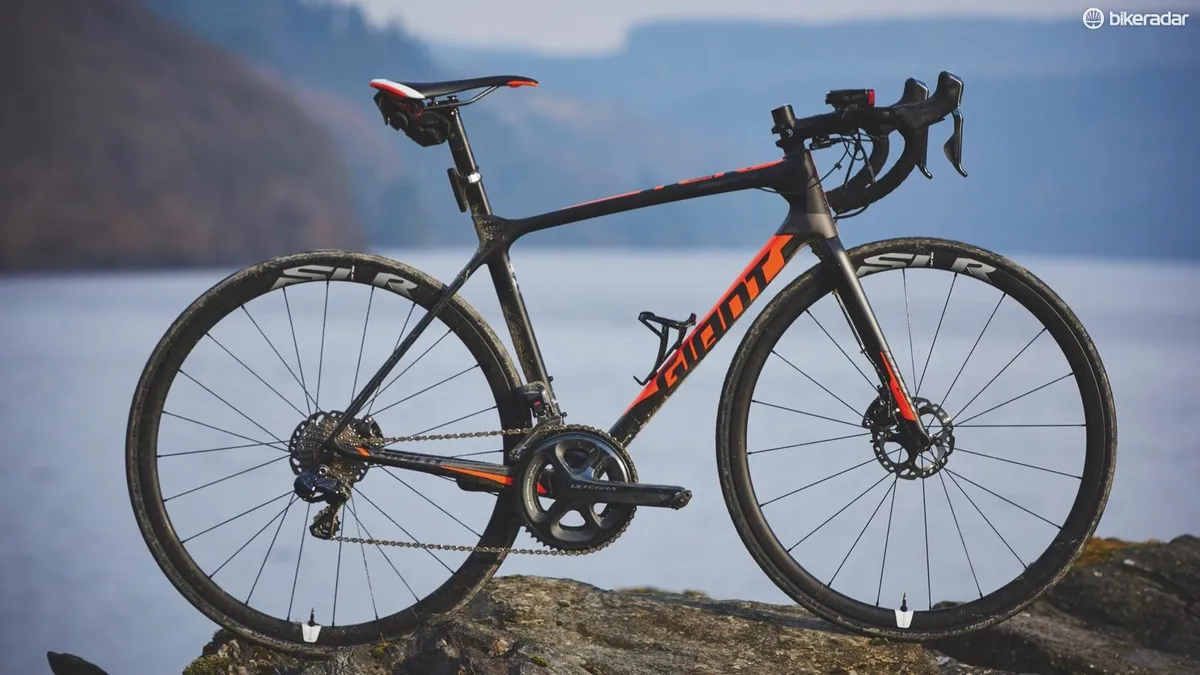
- Price: £3,799 / $4,700 / AU$5,299
- Weight: 7.8kg (M)
- Frame: Advanced Grade Composite
- Fork: Advanced Grade Composite (full carbon), OverDrive 2 steerer
- Gears: Shimano RS-785 levers, Ultegra Di2 52/36, 11-28
- Brakes: Shimano RS805 hydraulic disc
- Wheels: Giant SLR 1 tubeless carbon clincher
- Finishing kit: Giant Contact SL bar and stem, Contact SL Forward saddle, Variant Composite seatpost, Gavia SLR Tubeless 25mm tyres
Giant Road-E+ 1 specs
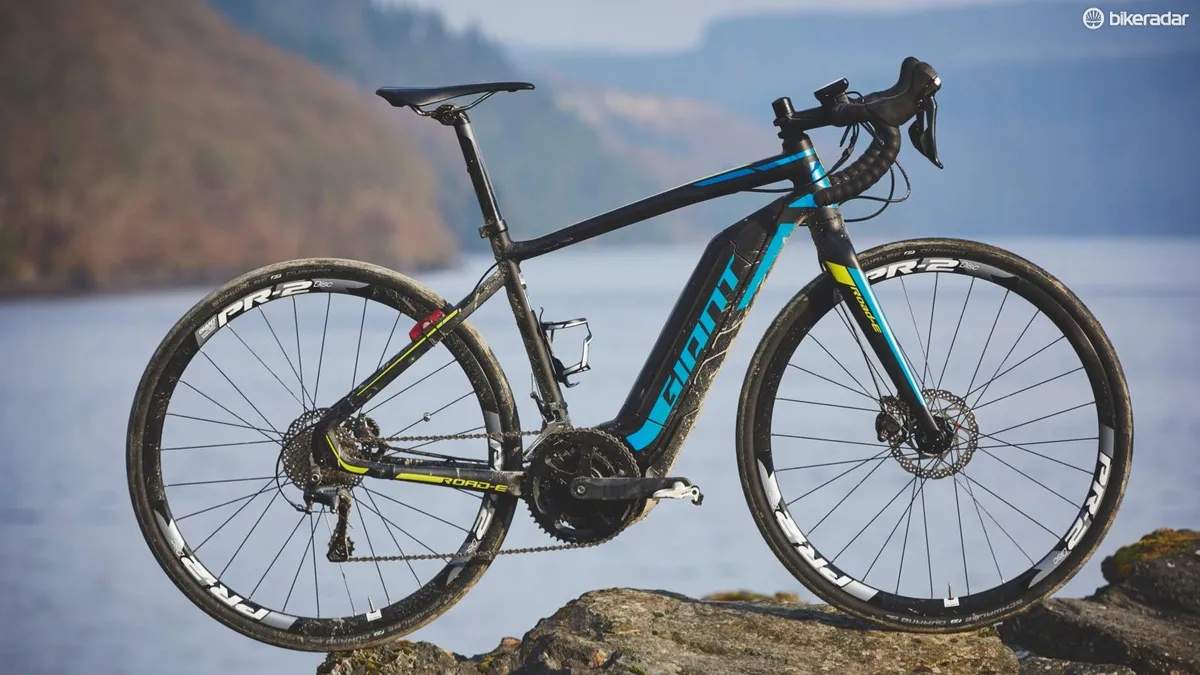
- Price: £3,349 / $4,000 / AU$N/A
- Weight: 19.8kg (M)
- Frame: Aluxx SL aluminium
- Fork: Aluxx SL aluminium, tapered steerer
- Motor: Giant/Yamaha SyncDrive Sport 80Nm, 250W
- Head unit: Giant RideControl EVO
- Gears: Shimano R685 levers, Ultegra mechs, FSA 50/34, 11-32
- Brakes: Shimano RS785 hydraulic disc
- Wheels: Giant P-R2 Disc alloy clincher
- Finishing kit: Giant Contact bar, Connect stem, Contact Composite seatpost, Contact SL saddle, Schwalbe Durano Performance Line 32mm tyres
Friend or foe?
I detailed my experience riding the Road-E+ at its launch last year in Austria, where the infamous Kitzbüheler Horn climb proved almost too much for this mechanically-doped machine. The thing might have overheated (Giant has subsequently told us that such abuse fell outside normal operating conditions, ergo, it wasn't its fault), but I came away deeply impressed with the potential entertainment value of electrified road bikes, and their ability to offer extraordinary riding experiences to cyclists who simply wouldn't contemplate tackling big distances or mountains on an ordinary bicycle.
The burning question for us now is whether e-bikes can ever coexist with normal ones, so to find out I recruited Cycling Plus' deputy art editor Rob Moxon to ride the Road-E+ with me on the un-assisted TCR. Rob is a moderately experienced cyclist who's let himself go a bit; and I'm a formerly serious cyclist who cheats by being abnormally thin. We are a match made, if not in heaven, then perhaps on one of the less well designed dating apps.
The dam united

We're testing on the roads that encircle Llyn Brianne reservoir in Carthmarthenshire, south west Wales. The scenery is that of Switzerland slightly shrunken; a huge Bond-esque dam holds the water back, and our ride begins by crossing it. The dam is closed to regular car traffic but there's nothing to stop you walking or riding over it. Once across, we bid farewell to tarmac for a while, zipping along a forestry road that's mostly packed dirt with a sprinkling of gravel.
Immediately I'm wondering if I've made a grave error. For all its qualities — light weight, stiffness, braking ability — the TCR is a race bike through and through and with the best will in the world, it's quite a firm riding thing on an unmetalled and unkempt surface.
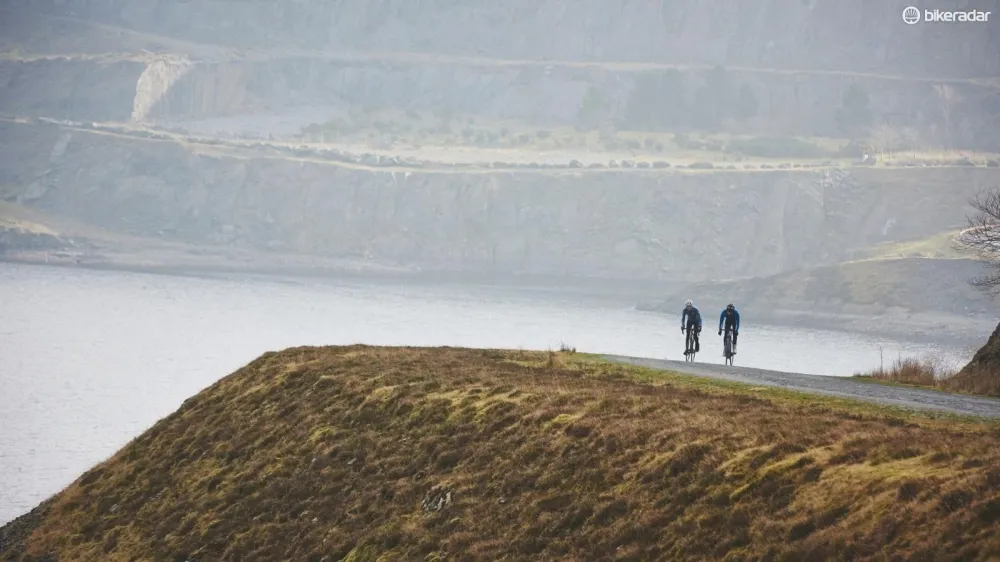
There is one saving grace however; although they measure just 25mm across, the TCR's tyres and rims are designed for tubeless, and the bike arrived sans-inners, with sealant sloshing around the rim. That means I don't have to run silly pressures as I rattle through the woods, and it gives me a little hope that my tyres will remain un-punctured. They do.
On the Road-E+, Rob is immediately sold on the concept of having to do very little work. It rapidly becomes apparent that on even the slightest uphill he can leave me in his dust, and he does so, repeatedly.
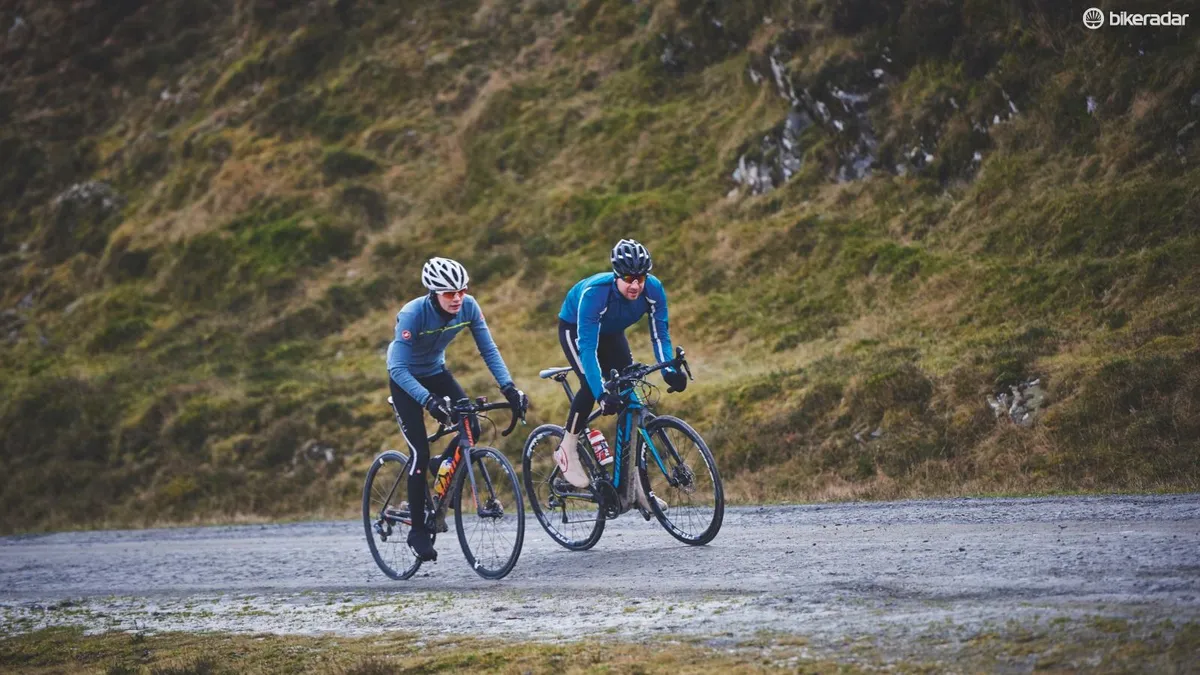
On 32mm rubber he's comfy and a little more confident in the corners too. We observe that there's room for considerably bigger tyres — electro-cross, anyone?The off-road excursion is punctuated by comically awkward interactions with gates and cattle grids, which serve to emphasise a key drawback of the e-bike; it weighs an absolute tonne, and lifting it above shoulder level when you have the gossamer build of a roadie (or a deputy art editor) is remarkably difficult.
Roads like these
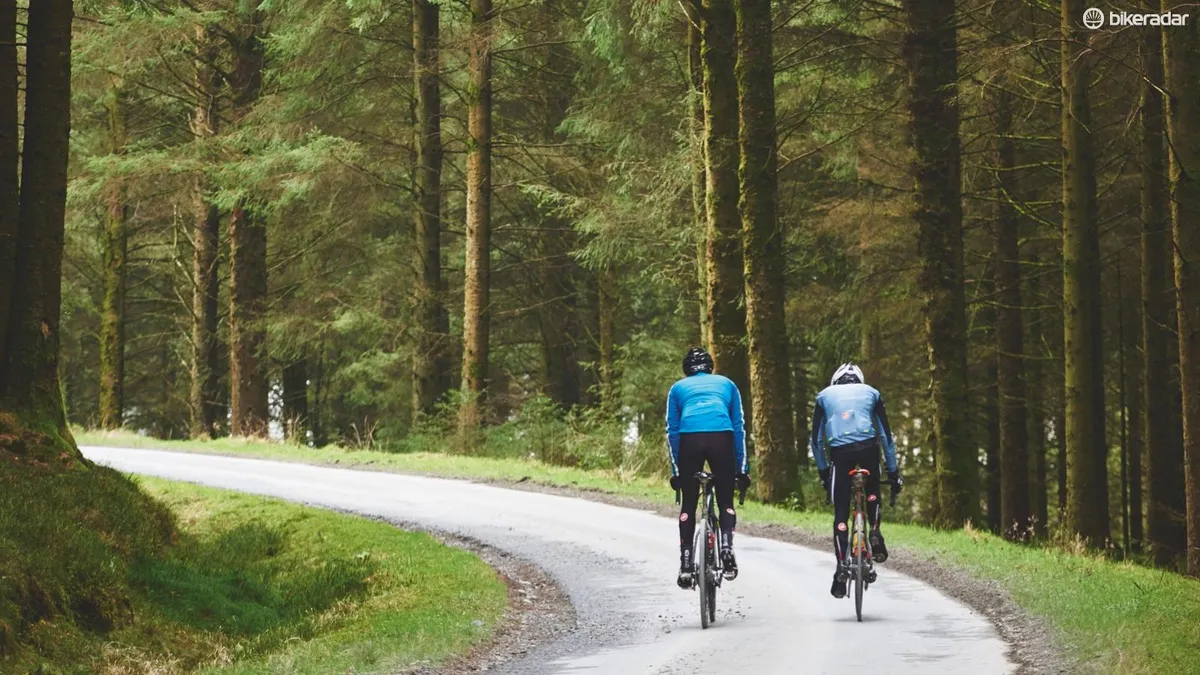
After some enjoyable skidding around, we are back on tarmac and it's as though we've been teleported to rural Canada. We're climbing through a stunning pine forest, catching glimpses of the reservoir as we go. We're getting used to the e-bike experience, and Rob has worked out that the choice of power mode is hugely important. The Road-E+ offers three levels of assistance, and in 'Eco' he can drop me on the climbs with a small effort. In 'Normal' he's barely trying and in Power he's gone before I can muster the breath to call him an arsehole. Which I eventually do, repeatedly.
The tables are turned when the gradient eases, because it's here that the limiter comes into play. Like all road-legal e-bikes in the UK, the Road-E+ cuts the power at speeds over 25 km/h (15.5mph), meaning that on flat sections, descents, and even very gentle climbs, Rob is deprived of assistance.
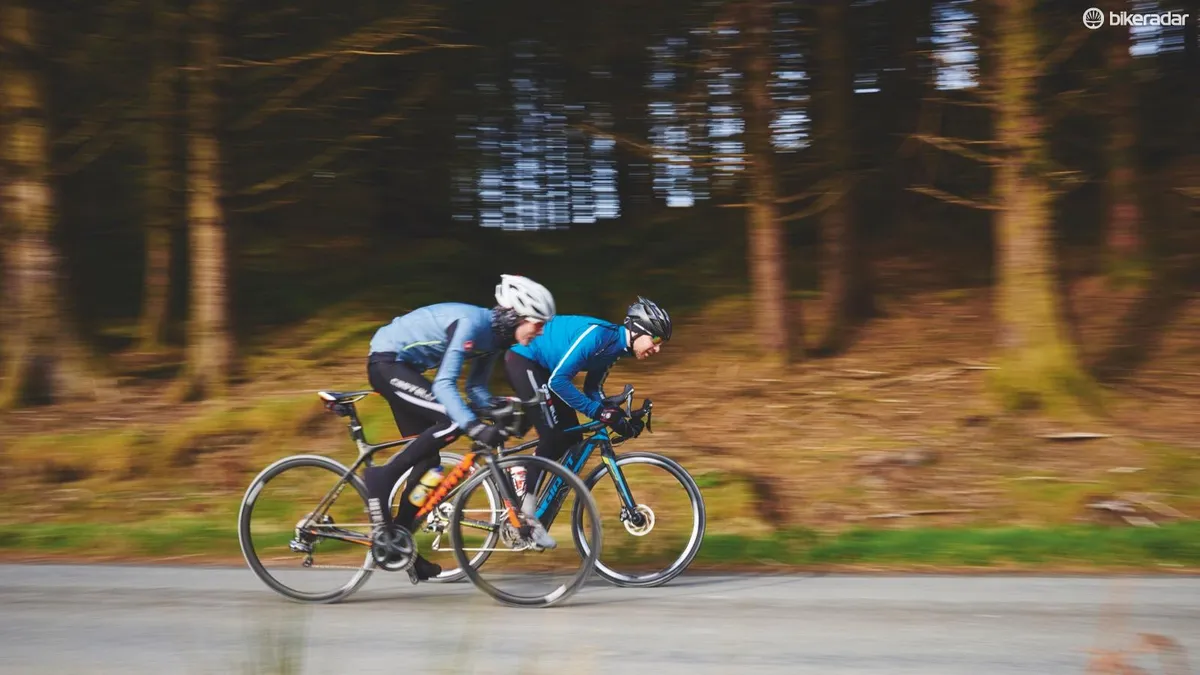
This has a curious effect on the riding experience — it doesn't matter heading downhill, where the bike's considerable mass is an asset, but on prolonged flats it can make for heavy going. Rob observes that it does have a pleasing way of amplifying momentum as he comes off a descent into the next climb, smoothing the transition as the power kicks in when his speed tapers below the limit. If there's one real chink in the e-bike's armour, it is that limiter. 25km/h is a sensible number for city-going hybrids that you ride to the shops, but it's irritatingly slow for a fit road cyclist on a flat road. Raising the limit by just five or 10km/h would make all the difference but as things stand, there's no legally advisable way to do that.
The roads here are completely stunning and the TCR is in its element, it really is an utter peach. It's completely composed and ruthlessly efficient.
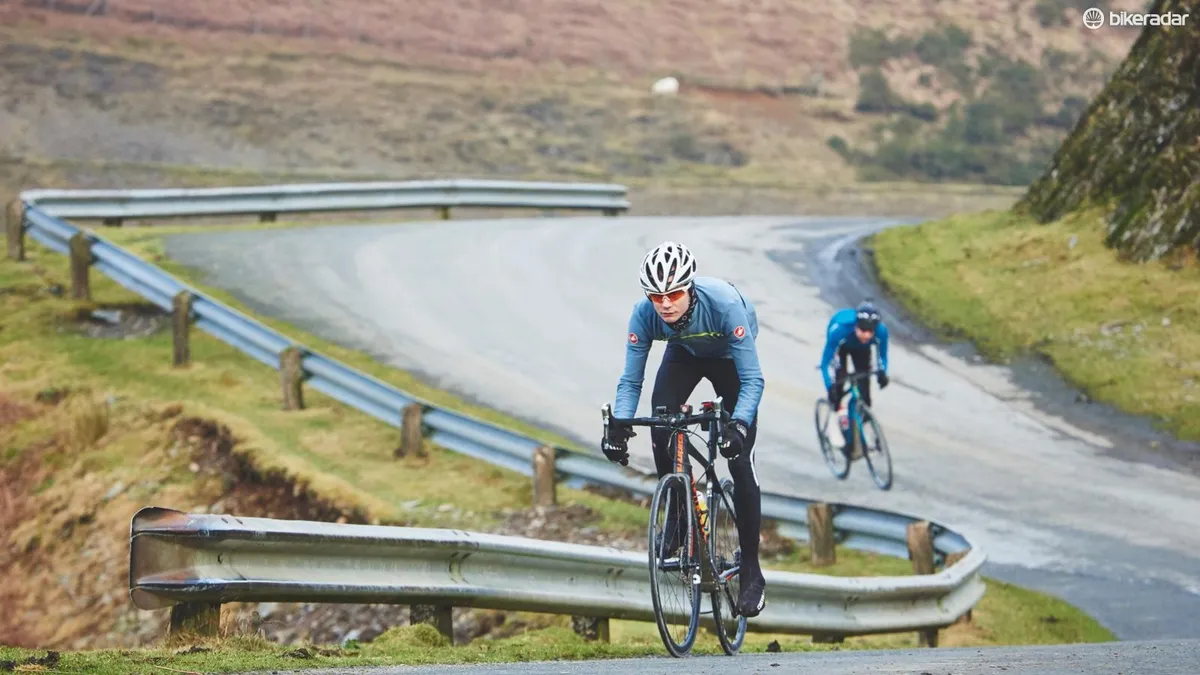
Stiff carbon wheels complement a stiff carbon frame, and the powerful brakes encourage acts of foolhardiness on technical descents. At times it's hard to decide if one should stop to take in yet another amazing vista, or press on to revel in the speed.By contrast, the Road-E+ seems rather basic, its frame is more like that of a standard bike costing a grand or so. With big tyres and power on tap, however it doesn't really matter. It may trundle rather than skim over ground, but a long wheelbase and good brakes give it an air of authority, a reassuring presence between your legs, as it were.
Before we know it, our ride is over, abbreviated by a prolonged attempt to unite a badly injured sheep with its owner, hindered by locals who ranged from the unhelpful to one possibly-possessed individual, Wales' answer to Deliverance. ("They eat their young you know," quoth he, referring to his neighbours, probably.) We end on a high however, satisfied that we've sussed the whole e-bike thing. We are fans.
Better together?

In answer to our original question, yes, an e-bike and an ordinary bike can coexist, but the success of the relationship hinges largely on communication and a willingness to be flexible with one's pace.
Heading uphill, the Road-E+ doesn't merely beat a self-propelled rider, it utterly annihilates them, regardless of fitness. The disparity can, however, be moderated to a considerable extent by the exercise of restraint, and its degree is highly dependent on the gradient.
It might not be welcome on your local club ride, but it's not difficult to imagine that the Road-E+ might be a great asset to couples where one party cycles casually and the other identifies as a serious cyclist. It could also be a complete boon to a physically challenged rider who just wants to keep cycling.
Whatever your reasons, we're confident that e-bikes are here to stay. In their current, slightly hobbled incarnation, they are a bit of a niche, but they're still tremendously capable and, more to the point, a hell of a lot of fun.
